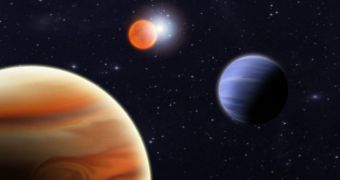We finally managed to reach the threshold! After 20 years of non-stop space studies, astronomers were able to move past the 500th exoplanet mark, as of November 19. Hundreds of other “candidate planets” are currently being investigated.
The list of known planets inside the Milky Way has been growing at an increased pace in recent years, with dozens of such bodies being discovered annually. Experts even managed to discover the first extragalactic exoplanet.
According to online database Extrasolar Planets Encyclopedia (EPE), the 500th exoplanet was discovered on Friday, November 19. The database is maintained by Paris-Meudon Observatory astrobiologist Jean Schneider.
The expert says that it is virtually impossible to determine precisely which body is the 500th. He explains that the planet was found in a batch of others, and that there is no way of knowing whether one or more of them will turn out to be a false alarm or not.
But, for all intents and purposes, the milestone discovery hides in one of four newly-found planets. They make the top of the EPE, following the exoplanet HIP 13044b, which lies in another galaxy.
The four bodies were found at distances ranging from 58 to 196 light-years form our solar system, which is basically in our backyard, in astronomical terms. None of them is larger than Jupiter.
In fact, their masses are between 15 and 50 percent that of our gas giant. One of them should theoretically holds the honorary title of the 500th found exoplanet, but deciding which one to bestow the honor upon is a matter of arbitrary decisions, not facts.
Astronomers are now more excited than ever, on account of the string of successes they registered in the past two months. They found the first potentially-habitable exoplanet, the first gas giant in another galaxy, and reached an important milestone in exoplanetary research.
But even this accomplishment may pale to what's in store for this field from the NASA Kepler Space Telescope, an instrument that was designed specifically to look for small, Earth-like planets.
“In some sense, 500 is an artificial milestone. It's much more fun to watch the nature of the discoveries change over time,” says SETI Institute expert and the Kepler analysis lead, Jon Jenkins.
“The variety of planets we've discovered has also increased,” adds the expert, quoted by Space. Thus far, Kepler found 700 planet candidates, of which several hundreds will surely be confirmed as such.
“Our false positive rate continues to be rather low. It appears to be below 20 percent,” Jenkins adds. This means that the 1,000th exoplanet could be discovered soon.
In the mean time, astronomers are using data of the existing planets to develop models of explaining a variety of issues, ranging from how planets form to how their parent stars affect their development and death.

 14 DAY TRIAL //
14 DAY TRIAL //